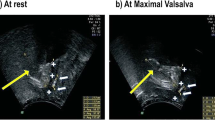Abstract
Introduction and hypothesis
One of the most frequent and distressing complications of the tension-free vaginal tape obturator (TVT-O) procedure for stress urinary incontinence (SUI) is groin pain, which may be related to the surgical technique or to the tape. The aim of this study was to evaluate the impact of a more limited dissection and a more medial trocar trajectory in TVT-O positioning on postoperative pain.
Methods
Seventy-two SUI patients were randomized to undergo TVT-O either with the traditional technique (group A) or a modified procedure (reduced paraurethral dissection and a more medial trocar trajectory) (group B). Visual analog scale pain scores 12 h, 24 h, and 1 month after the procedure, number of analgesic vials, objective cure rate, and patient functional and quality of life scores 6 months after the procedure were evaluated. Data were analyzed by the Student’s t test for parametric variables, the Mann–Whitney U and Wilcoxon tests for nonparametric variables, and Fisher’s exact test for categorical variables.
Results
Pain scores were significantly lower in group B compared with group A 24 h after surgery (P = 0.01). Pain scores significantly decreased from 12–24 h postoperatively to 1 month follow-up in both groups (P < 0.001). No significant differences were observed in the number of analgesic vials administered, cure rates, and questionnaire scores between the two groups.
Conclusions
More limited dissection and a more medial trocar trajectory of TVT-O seem to reduce postoperative groin pain at 24 h after the procedure, but not the analgesic requirement.




Similar content being viewed by others
References
Delorme E (2001) Transobturator urethral suspension: mini-invasive procedure in the treatment of stress urinary incontinence in women. Prog Urol 11:1306–1313
Minaglia S, Ozel B, Klutke C, Ballard C, Klutke J (2004) Bladder injury during transobturator sling. Urology 64:376–377
de Leval J (2003) Novel surgical technique for the treatment of female stress urinary incontinence: transobturator vaginal tape inside-out. Eur Urol 44:724–730
Latthe PM, Foon R, Toozs-Hobson P (2007) Transobturator and retropubic tape procedures in stress urinary incontinence: a systematic review and meta-analysis of effectiveness and complications. BJOG 114:522–531
Ogah J, Cody JD, Rogerson L (2009) Minimally invasive synthetic suburethral sling operations for stress urinary incontinence in women. Cochrane Database Syst Rev 4:CD006375
Novara G, Artibani W, Barber MD et al (2010) Updated systematic review and meta-analysis of the comparative data on colposuspensions, pubovaginal slings, and midurethral tapes in the surgical treatment of female stress urinary incontinence. Eur Urol 58:218–238
Waltregny D, de Leval J (2009) The TVT-obturator surgical procedure for the treatment of female stress urinary incontinence: a clinical update. Int Urogynecol J Pelvic Floor Dysfunct 20:337–348
Debodinance P (2007) Trans-obturator urethral sling for the surgical correction of female stress urinary incontinence: outside-in (Monarc®) versus inside-out (TVT-O®). Are the two ways reassuring? Eur J Obstet Gynecol Reprod Biol 133:232–238
Tamussino K, Hanzal E, Kölle D, Tammaa A, Preyer O, Umek W et al (2007) Transobturator tapes for stress urinary incontinence: results of the Austrian registry. Am J Obstet Gynecol 197(6):634.e1–634.e5
Liapis A, Bakas P, Creatsas G (2008) Monarc vs TVT-O for the treatment of primary stress incontinence: a randomized study. Int Urogynecol J Pelvic Floor Dysfunct 19:185–190
But I, Faganelj M (2008) Complications and short-term results of two different transobturator techniques for surgical treatment of women with urinary incontinence: a randomized study. Int Urogynecol J Pelvic Floor Dysfunct 19:857–861
Lee KS, Choo MS, Lee YS, Han JY, Kim JY, Jung BJ, Han DH (2008) Prospective comparison of the ‘inside-out’ and ‘outside-in’ transobturator-tape procedures for the treatment of female stress urinary incontinence. Int Urogynecol J Pelvic Floor Dysfunct 19:577–582
Abdel-Fattah M, Ramsay I, Pringle S et al (2010) Randomised prospective single-blinded study comparing ‘inside-out’ versus ‘outside-in’ transobturator tapes in the management of urodynamic stress incontinence: 1-year outcomes from the E-TOT study. BJOG 117:870–878
de Leval J, Thomas A, Waltregny D (2011) The original versus a modified inside-out transobturator procedure: 1-year results of a prospective randomized trial. Int Urogynecol J 22:145–156
Bushnell DM, Martin ML, Summers KH, Svihra J, Lionis C, Patrick DL (2005) Quality of life of women with urinary incontinence: cross-cultural performance of 15 language versions of the I-QOL. Qual Life Res 14:1901–1913
Rogers RG, Coates KW, Kammerer-Doak D, Khalsa S, Qualls C (2003) A short form of the Pelvic Organ Prolapse/Urinary Incontinence Sexual Questionnaire (PISQ-12). Int Urogynecol J Pelvic Floor Dysfunct 14:164–168
Meschia M, Barbacini P, Ambrogi V, Pifarotti P, Ricci L, Spreafico L (2009) TVT-Secur: a minimally invasive procedure for the treatment of primary stress urinary incontinence. One year data from a multi-centre prospective trial. Int Urogynecol J Pelvic Floor Dysfunct 20:313–317
Hinoul P, Bonnet P, Krofta L, Waltregny D, de Leval J (2011) An anatomic comparison of the original versus a modified inside-out transobturator procedure. Int Urogynecol J 22:997–1004
Tommaselli GA, D’Afiero A, Di Carlo C, Formisano C, Fabozzi A, Nappi C (2011) Effect of a modified surgical technique for the positioning of TVT-O on post-operative pain. Int Urogynecol J 22(Suppl 1):S-110
Conflicts of interest
Giovanni A. Tommaselli and Carmine Nappi accepted paid expenses from Gynecare; all other authors state that they have no conflicts of interest.
Author information
Authors and Affiliations
Corresponding author
Electronic supplementary material
Below is the link to the electronic supplementary material.
ESM 1
(DOC 219 kb)
Rights and permissions
About this article
Cite this article
Tommaselli, G.A., Formisano, C., Di Carlo, C. et al. Effects of a modified technique for TVT-O positioning on postoperative pain: single-blind randomized study. Int Urogynecol J 23, 1293–1299 (2012). https://doi.org/10.1007/s00192-012-1758-3
Received:
Accepted:
Published:
Issue Date:
DOI: https://doi.org/10.1007/s00192-012-1758-3




